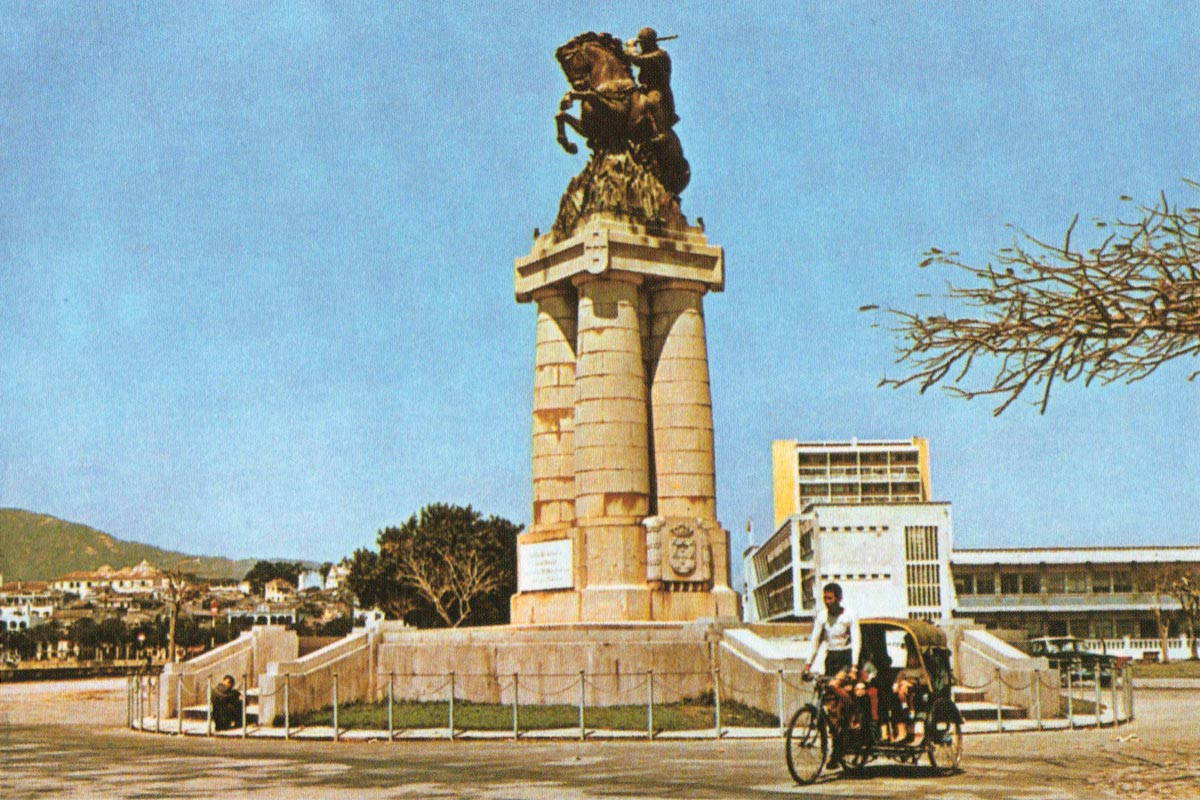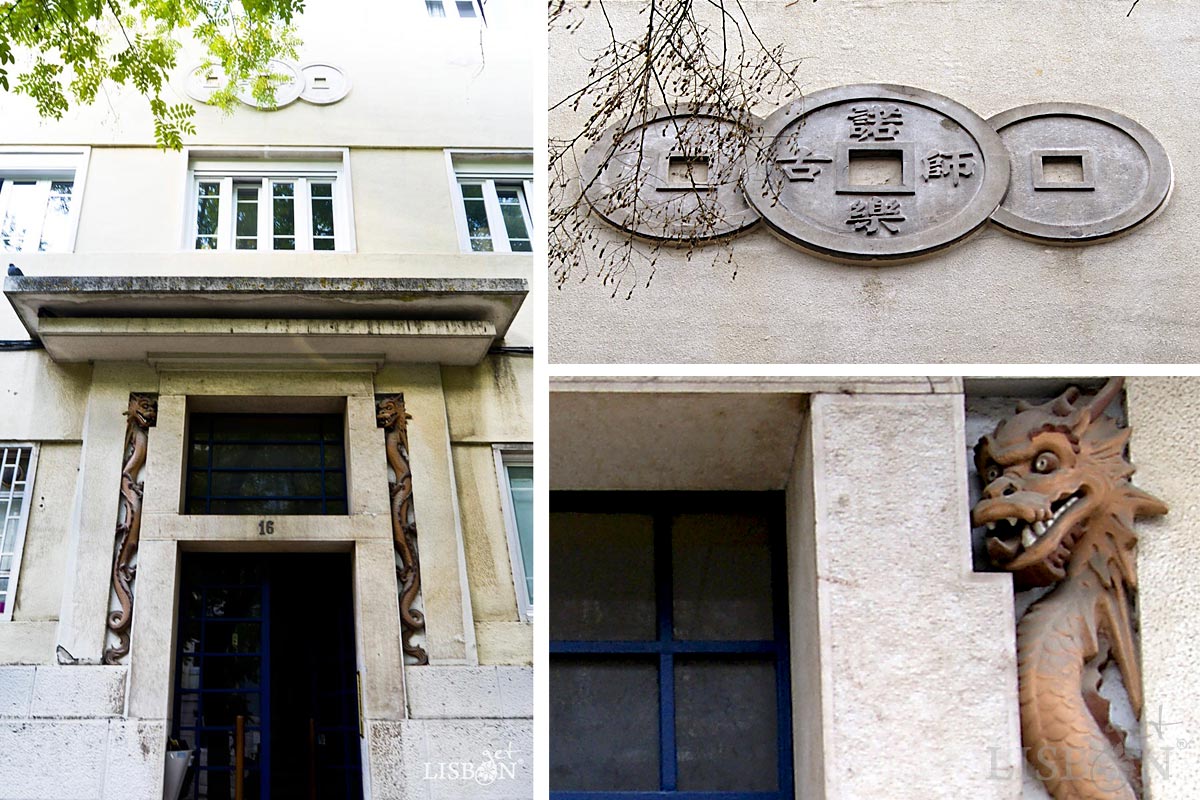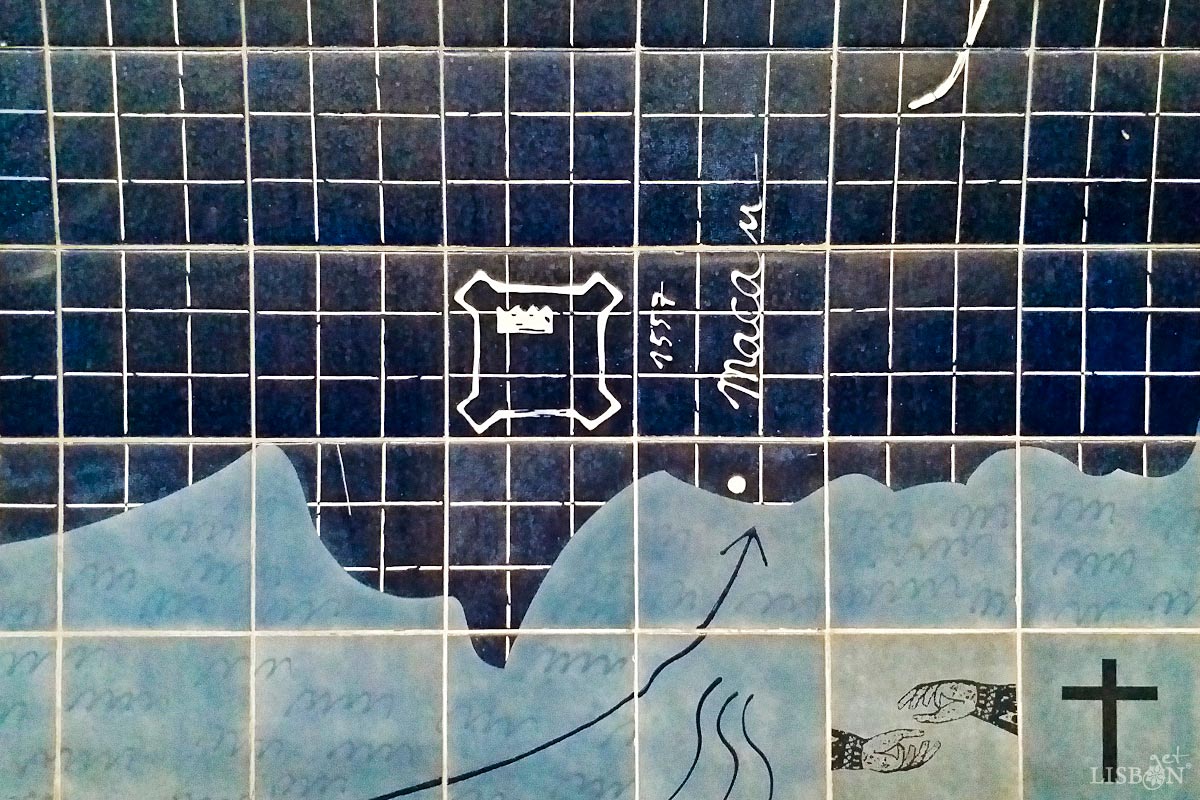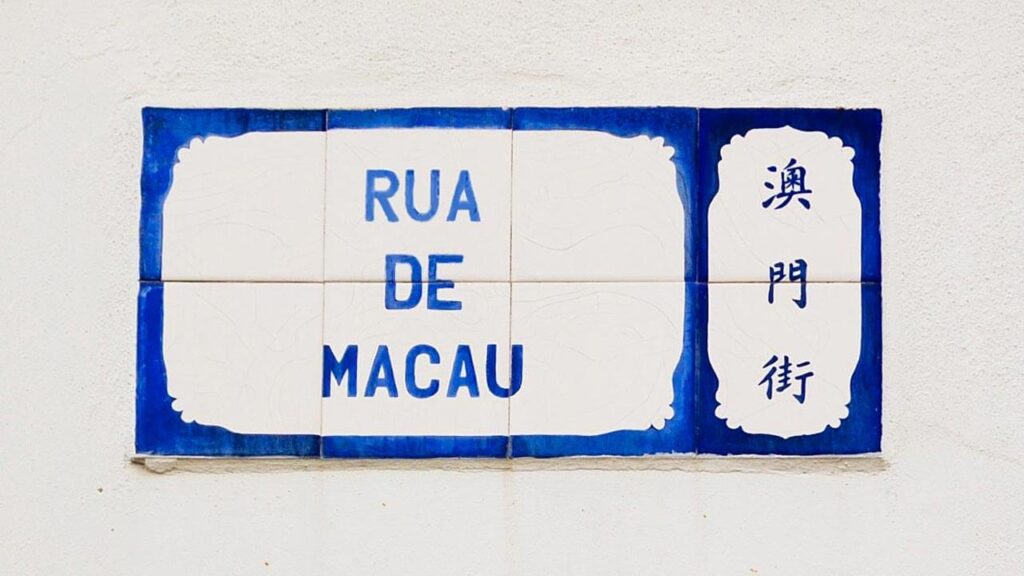Today we bring you a bit of the history between Portugal and China through 7 marks of Macau in Lisbon that getLISBON, during its wanderings through the city, had the opportunity of gathering.
Why Macau? The explanation is simple: 50% of the genetic code of getLISBON is of Macanese origin. 🙂
We will also suggest what could be interesting to get to know around these 7 marks of Macau in Lisbon so that you can enjoy your walk better.
But first it’s important to know a bit about Macau: a result of the sea exploration of the Portuguese in the 16th century that originated the crossing of cultures and a sharing with more than 450 years.

Brief Words about Macau
This faraway place in the East, in the Pearl River delta, was inhabited by fishermen and peasants.
The first Portuguese ships, in order to shelter from bad weather, entered in the bay where there was a temple dedicated to A-Ma, the sea goddess. It is said that the designation of Macau emerged when the Portuguese asked the name of this region and the fishermen replied with: A-Ma Gau (port or bay of A-Ma).
Although the Portuguese expeditions to the East for the establishment of diplomatic and commercial relations occurred right in the beginning of the 16th century, only in 1554 did Portugal obtain authorisation to trade freely in Canton, having thus been the first European nation to establish itself in China.
It is believed that the conveyance of Macau to Portugal in 1557 was one of the rewards from the Chinese authorities for the help from the Portuguese against the pirates in the region. The access to products from the West was equally one of the reasons for the convenience of the stay of these foreigners in Chinese territory.
For centuries, Macau benefited from the commercial flourishing that the Portuguese intermediated between China and other parts of the world. The population increased with people from everywhere looking for a free and safe port, an authentic cosmopolitan land.
Moreover, according to tradition Luís de Camões (Portuguese famous poet) arrived
After more than three centuries of being in the territory, only in 1887 was the sovereignty of Macau recognised to the Portuguese, through the Sino-Portuguese Treaty of Peking.
With the revolution of April 1974, Portugal began the process of independence of all its ultramarine territories. In the case of Macau, this process was initiated in 1985 and in 1999 the sovereignty returned definitively to China.


Marks of Macau in Lisbon
They were more than four centuries of unity, experience and intense sharing. Today, although the sovereignty of Macau doesn’t belong to Portugal anymore, its heritage still remains rooted.
And the testimony of a historical sharing can be revealed in simple references, details that many times go unnoticed, but that bring us back to significant episodes.
We will thus show you the 7 marks of Macau in Lisbon that we’ve selected for you.
The first one navigated thousands of kilometres to arrive to the city of the Seven Hills.
The Statue of Ferreira do Amaral

João Maria Ferreira do Amaral (1803-1849) was a Portuguese military and politician that in 1846 became the first Governor of Macau.
His energetic measures to defend Portugal’s interests displeased the Mandarins, and the conflict culminated in his assassination in 1849.
It is known that in 1879 the body of Ferreira do Amaral was transported to the Prazeres Cemetery in Lisbon.
In 1940, 91 years after his death, was erected in the Ferreira do Amaral Square in Macau an imposing monument in his honour.

However, his monument was dismantled in 1992 and, posteriorly sent to Lisbon.
In 1999, the City Council of Lisbon ordered placed the statue of Ferreira do Amaral in Alameda da Encarnação, in the North Zone of the city.
This work, from the sculptor Maximiliano Alves, lost the base with architectural value, which gave it monumentality. However, being able to take a close look allows a distinct and detailed observation.
You can also take a walk in the peaceful Encarnação Neighbourhood, built in the 1930’s, with wide roads and single-family homes. One of the examples of the urbanistic theory of city-garden that intended to take advantage of the best of the city and the countryside put into practice.
A Building with Oriental Inscriptions

In Ressano Garcia Avenue, no.16 in the zone of Avenidas Novas there is a building with an Oriental decoration that caught our attention.
In the site Memória para Todos, owned by the Institute of Contemporary History – NOVA FCSH, it was possible to find interesting information.
The building, inaugurated in 1935, was designed by the architect Norte Júnior (1878-1962) and its decoration reveals the oriental cultural roots of its owner.
The building was ordered built by José Maria Nolasco da Silva, from Macau, that settled down in Portugal in 1929, after retiring.
The entrance door has a structure inspired by the portals of Shinto temples, flanked by two low-relief dragons.
Above the door we can see 3 Chinese coins, symbols of prosperity.
This type of Chinese coin has four characters engraved that generally indicated the name of the Emperor of the time they were coined. In the same way, José Maria Nolasco da Silva wanted his name to be inscribed in the middle coin in order to have good luck and fortune.
After this curious observation, we have two suggestions of visits that are very near this building that is one of the marks of Macau in Lisbon: the Central Mosque of Lisbon, the main mosque of the Islamic Portuguese community and the Calouste Gulbenkian Foundation with its valuable collections and pleasant garden.
Metro Station

One of the most convenient ways of getting around Lisbon is without a doubt the metro.
Did you know that in one of the stations you can find a small mark of Macau?
The station Parque, blue line, is part of one of the first stations of the Lisbon Metro network, inaugurated in 1959. The entrance is covered in tiles with geometrical compositions in the colours white, green, brown and black from the painter Maria Keil (1914-2012).
In 1994 the entire interior of this station suffered a significant plastic arts intervention and today it is one of the richest and most enigmatic metro stations.
The intervention, in tiles and sculptures, by the Belgian artist Françoise Schein and the French artist Federica Matta focuses on two themes and, in its whole, deserves to be admired.
The theme of the Universal Declaration of Human Rights is represented with the thirty articles inscripted in the central nave of this station and the theme of the Portuguese expansion and discoveries through the routes that the Portuguese explored throughout the world.
Macau is represented in the panel at the end of the platform.
Let us know if you found it!
Coat of Arms of the Old Portuguese Overseas Provinces

In the main façade of the BNU’s (National Overseas Bank) old headquarter building, currently MUDE – Museum of Design and Fashion, situated in Rua Augusta, exists a coat of arms of the old Portuguese overseas provinces.
This high-relief created by the sculptor Leopoldo de Almeida (1898-1975) is constituted by coats of arms of the overseas territories where BNU was an issuing bank.
From left to right we can identify the coat of arms of Timor, São Tomé e Príncipe, Goa, Mozambique, Portuguese Guinea, Cabo Verde and finally, Macau, represented by a Chinese armed dragon.
Since it is located in Downtown Lisbon we suggest you go to the Nossa Senhora da Oliveira Church in Rua de São Julião and get to know its surprising tile panels of the 18th century.
Flag of Leal Senado – Municipal Council of Macau

Do you know where to find the flag of the Leal Senado of Macau?
The flag was removed from the Leal Senado (Loyal Senate – official denomination of the Municipal Council of Macau) on the 20th December 1999, date of the transfer of sovereignty of Macau to the People’s Republic of China. At the initiative of Dr Jorge Rangel, a personality closely linked to the process of transfer of sovereignty, this flag was offered to the Historical Society of the Independence of Portugal in October 2003.
You can see it in the Palace of Independence, where this society is based, in São Domingos Square right next to Rossio.
On a blue background, this flag is composed by the Portuguese shield in the centre, held by two angels. The shield has a crown, which is flanked by the Christ Cross on the left and by an armillary sphere on the right. Below you can read “Cidade do Nome de Deus de Macau, Não Há Outra Mais Leal” (directly translated to City of the Name of God of Macau, There is No Other More Loyal City), designation
Although it isn’t the official flag of the territory of Macau under the Portuguese administration, this representation was many times used internationally, including in the ceremony of the transfer of sovereignty along with the Portuguese flag.
As for the Independence Palace, besides being classified as a National Monument, it has a very relevant artistic and historical value. Among many other stories that can be told, it was in this building that the conspirators that led to the restoration of the Independence of Portugal in 1640 met secretly. It was also one of the few buildings in Pombaline Downtown that survived the earthquake of 1755.
In addition to being a must-visit place, it features one of the marks of Macau in Lisbon!
| Never miss another article | Subscribe here |
Portal of Macau

In the Tropical Botanical Garden, located in the area of Belém, you can find one of the marks of Macau in Lisbon.
This garden, previously designated Colonial Garden, was created in 1906 with the purpose of the organisation of the colonial agricultural services and of the Colonial Agronomic Education in the Institute of Agronomy and Veterinary.
Today we can observe in this garden elements evocative of the colonies, namely African and Asian busts, buildings and tile panels that were part of the Exhibition of the Portuguese World, promoted by the Estado Novo (nationalist corporatist authoritarian regime installed in Portugal from 1933 to 1974) in 1940.
In this context, you can find the red Portal of Macau, traditional Chinese structure that marks the entrance of the small oriental garden of Asian species.
Take this chance to visit this garden that was classified in 2007 as National Monument and that has more than 600 species from several continents.
Since you’re nearby, you can’t miss the opportunity to enjoy the famous pastéis de Belém, as well as to visit the Recreational Park of Moinhos de Santana where exist two mills from the 18th century and from there to appreciate the view of the West Zone of Lisbon.
Rua de Macau

Of course we’d have to find a reference of Macau in the toponymy of Lisbon.
The Rua de Macau is located in the old Bairro das Colónias (directly translated to Neighbourhood of the Colonies), that after the revolution of April was called Bairro das Novas Nações (directly translated to Neighbourhood of the New Nations).
This was a project initiated in the first decades of the 20th century. Its buildings, built from the 1920’s until the end of the 1940’s, are predominantly Art Deco and modernist.
Parallel to the cross-cultural heritage of the Macanese, the Bairro das Colónias is integrated in the Parish of Arroios, the most multicultural of Lisbon.
It has suffered major transformations and renovations and from being a zone of dubious reputation, it became an area that is quite sought by young people and people from many different places of the world that want to live in Lisbon.
Here you can find establishments of diversified gastronomies, simple or more modern, shops and supermarkets of oriental or Eastern Europe products, as well as traditional local commerce characteristic of a neighbourhood with history.
Take the chance to go up to the Monte Agudo Viewpoint through the stairs in Rua Ilha do Príncipe. From there you have a magnificent and less-known observation point.
We’ve reached the end of this search for marks of Macau in Lisbon, with the certainty that there will be many others to point out. We challenge our readers to contribute with theirs…
Also read 7 Marks of Lisbon in Macau, a sort of reverse of this article.
The project getLISBON has been very rewarding and we want to continue revealing the singularities of fascinating Lisbon.
Help us keep this project alive!
By using these links to make your reservations you’ll be supporting us. With no extra costs!
• Looking for a different experience? We can create a customised itinerary based on your interests. Contact us!
• Or if you prefer tours and other activities in various destinations, take a look at GetYourGuide.
• Save time and money with a flexible Lisbon Card!




